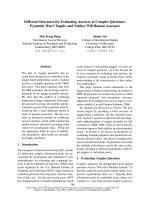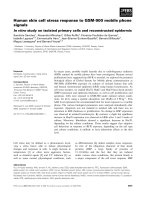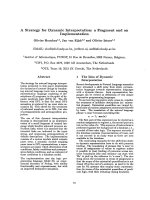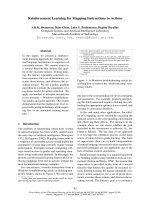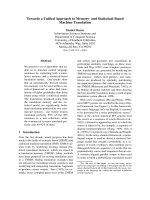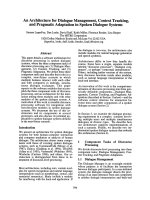báo cáo khoa học: "Bidirectional selection for olfactory response to acetaldehyde and ethanol in Drosophila melanogaster" docx
Bạn đang xem bản rút gọn của tài liệu. Xem và tải ngay bản đầy đủ của tài liệu tại đây (834.97 KB, 17 trang )
Bidirectional
selection
for
olfactory
response
to
acetaldehyde
and
ethanol
in
Drosophila
melanogaster
A.A.
HOFFMANN
Department
of
Genetics
and
Huinan
Variation,
La
Trobe
Univer.sity
Buncloora,
Victoria,
Au.stralia,
3083
Summary
Dro.sophila
melanogaster
adults
were
successfully
selected
for
increased
and
decreased
olfactory
response
to
different
concentrations
of
acetaldehyde
and
ethanol,
using
a
choice
type
olfactometer.
The
response
to
selection
was
not
concentration
specific.
Lines
were
also tested
with
n-propa,nol,
n-butanol,
acetic
acid,
propionic
acid,
benzal-
dehyde,
methyl
acetate,
ethyl
acetate
and
3-hydroxybutan-2-one.
The
behaviour
of
the
lines
was
similar
for
most
of
these
chemicals,
indicating
an
odorant
specific
response
to
selection.
However,
ethanol
selected
lines
differed
in
their
response
to
n-propanol
and
possibly
n-butanol,
suggesting
a
role
for
the
alcohol
group
in
determining
the
specifici
’
ty
of
genetic
variation
in
olfactory
response.
Utilization
of
acetic
acid,
ethanol
and
acetaldehyde
as
resources
by
the
selected
lines
was
tested
using
adult
longevity.
The
only
significant
result
was
that
lines
selected
for
increased
attraction
to
ethanol
utilised
9
p.
100
and
12
p.
100
ethanol
more
than
lines
selected
for
decreased
attraction.
Gene
frequencies
were
monitored
at
3
enzyme
loci
-
alcohol
dehydrogenase,
triose
phosphate
isomerase,
a-glycerophosphate
dehydrogenase
-
associated
with
the
metabolism
of
ethanol
and
acetaldehyde.
There
were
no
changes
associated
with
the
response
to
selection,
and
the
ADH-F
allele
increased
in
both
selected
and
unselected
lines.
Key
words :
Olfactory
re.sponse,
Drosophila
melanogaster,
behaviour
genetic
variation,
resource
utilization.
Résumé
Sélection
bidirectionnelle
de
la
réponse
olfactive
à
l’acétaldéhyde
et
à
l’éthanol
chez
D.
melanogaster
Des
adultes
de
Drosophila
melanogaster
ont
été
sélectionnés
avec
succès
pour
un
accroissement
ou une
diminution
de
la
réponse
olfactive
à
différentes
concentrations
d’acétaldéhyde
ou
d’éthanol.
La
sélection
a
été
faite
dans
un
olfactomètre
à
choix
et
la
réponse
obtenue
n’est
pas
spécifique
de
la
concentration.
Les
lignées
ont
été
aussi
testées
avec
le
n-propanol,
n-butanol,
l’acide
acétique,
l’acide
proprionique,
le
benzaldéhyde,
l’acétate
de
méthyle,
l’acétate
d’éthyle
et
le
3-hydroxy-2-
butanone.
Le
comportement
des
lignées
a
été
semblable
pour
la
plupart
de
ces
produits,
montrant
que
la
sélection
concerne
la
capacité
de
réponse
à
une
odeur.
Cependant,
les
lignées
sélectionnées
pour
l’éthanol
ont
différé
dans
leur
réponse
au
n-propanol
et
peut-être
au
n-butanol,
suggérant
que
le
groupe
alcool
a
pu
jouer
un
rôle
dans
la
spécificité
de
la
variation
génétique
de
la
réponse
olfactive.
L’utilisation
de
l’acide
acétique,
de
l’éthanol
et
de
l’acétaldéhyde
comme
ressource
a
été
testée
chez
les
lignées
sélectionnées
grâce
à
une
étude
de
la
longévité.
Le
seul
résultat
significatif
a
été
que
les
lignées
sélectionnées
pour
une
plus
forte
attraction
par
l’éthanol
utilisaient,
mieux
que
les
lignées
sélectionnées
pour
une
attraction
décroissante,
des
concen-
trations
d’alcool
de
9
et
12
p.
100.
Les
fréquences
géniques
ont
été
étudiées
à
3
locus
enzymatiques
-
la
déshydrogénase
alcoolique,
la
triose
phosphate
isomérase
et
l’a-glycérophosphate
déshydrogénase
-
qui
sont
associés
au
métabolisme
de
l’éthanol
et
de
l’acétaldéhyde :
aucune
modification
associée
à
la
sélection
n’a
été
obtenue.
L’allèle
Adh
F
a
augmenté
de
fréquence
à
la
fois
dans
les
lignées
sélectionnées
et
non
sélectionnées.
Mots
clés :
Réponse
olfactive,
Drosophila
melanogaster,
variation
génétique
du
compor-
tement,
utilisation
des
ressources.
I.
Introduction
Olfaction
is
important
in
both
long
and
short
distance
location
of
food
by
Droso-
phila
(BARROW,
1907 ;
K
ELLOGG
et
C
ll.,
1962 ;
K
ENNEDY
,
1977
a).
F
UYAMA
(1976)
has
described
olfactory
response
variation
among
geographic
strains
of
D.
melanogaster
for
ethanol,
ethyl
acetate,
n-butyraldehyde,
and
lactic
acid,
suggesting
genetic
variation
in
olfactory
response
in
natural
populations.
Further
genetic
studies
by
F
UYAMA
(1978)
using
chromosome
II
lines
derived
from
a
natural
population
indicated
associations
among
the
odorants
tested.
Variability
among
the
lines
was
specific
to
esters
and
ketones,
while
the
responses
of
the
lines
to
these
odorants
were
negatively
correlated
with
their
response
to
lactic
acid.
Such
odorant
specific
genetic
variation
in
olfaction
may
be
important
in
differential
habitat
utilization.
One
group
of
chemicals
which
has
been
studied
from
this
perspective
is
ethanol
and
products
associated
with
its
metaboLism.
These
fermentation
products
are
present
at
high
concentrations
in
Drosophila
food
resources
(M
CK
ECHNIE
&
MO
RGAN
,
1982 ;
MCK
ENZIE
&
McKECIINIE,
1979)
and
are
attractive
to
Drosophila
adults
(H
UTNER
et
C
11.,
1937 ;
WEST,
1961).
Ethanol,
acetaldehyde
and
acetic
acid
are
also
used
as
resources
in
laboratory
experiments
(PARSONS
&
S
PEN
CE,
1981 ;
MoxoN et
al.,
1982).
Studies
with
Drosophila
at
the
interspecific
level
have
often
indicated
a
direct
relationship
between
the
utilization
of
these
chemicals
and
an
elicited
behavioural
response.
Examples
are
the
oviposition
behaviours
of
D.
simulans
and
D.
melanogaster
on
ethanol
containing
medium
(M
CK
ENZIE
&
PARSONS,
1972)
and
the
larval
attraction
behaviours
of
these
two
species
and
D.
immigrans
to
ethanol
and
acetic
acid
(PARSONS
&
S
PENCE
,
1981).
At
the
intraspecific
level,
G
ELFAND
&
MC
IJ
ONALD
(1980)
and
C
AVENER
(1979)
have
suggested
a
relationship
between
the
alcohol
dehydrogenase
(ADH)
allozymes
involved
in
the
utilization
of
ethanol
and
larval
responses
to
this
chemical.
Studies
with
ADH
null
strains
also
indicate
an
association
between
ADH
activity
and
both
larval
response
to
ethanol
(PARSONS
&
S
PENCE
,
1981)
and
oviposition
on
ethanol
containing
medium
(H
OUGOUTO
et
al.,
1982).
In
this
paper,
I
describe
the
response
of
a
genetically
heterogeneous
D.
melano-
gaster
population
to
selection
for
increased
and
decreased
attractiveness
to
ethanol
and
the
metabolically
related
acetaldehyde.
This
experiment
was
carried
out
to
determine
whether
odorant
specific
olfactory
genetic
variation
to
these
common
fermentation
products
exists,
and
whether
an
alteration
of
olfactory
response
is
accompanied
by
a
correlated
response
in
the
utilization
of
these
chemicals
as
resources.
The
specificity
of
the
selection
response
was
determined
by
comparing
the
behaviour
of
the
selected
lines
with
other
naturally
occuring
chemicals.
Resource
utilization
was
studied
by
measuring
adult
longevity
in
the
presence
of
these
chemicals.
Gene
frequencies
were
also
monitored
at
three
enzyme
loci
-
triose
phosphate
isomerase
(TPI),
a-glycero-
phosphate
dehydrogenase
(GPDH)
and
ADH —
involved
in
the
metabolism
of
these
chemicals.
ADH
and
GPDH
cooperate
metabolically
in
breaking
down
ingested
alcohol
and
the
subsequent
synthesis
of
triglycerides/phosphatidic
acids.
Dihydroxyacetone
phosphate
is
the
common
substrate
for
TPI
and
GPDH,
occupying
a
central
position
in
the
distribution
of
triosephosphates
for
glycolysis
and
triglyceride/phosphatidic
acid
synthesis
(S
ACKTOR
,
1974).
I1.
Materials
and
methods
A.
Stocks
Flies
were
obtained
from
a
recently
established
population
cage
initiated
by
50
females
caught
at
an
orchard
site
near
Melbourne,
Victoria.
All
stocks
were
maintained
at
25
°C
on
sugar-agar-dead
yeast
medium.
B.
Olfactometry
A
simple
olfactometer
was
constructed
(fig.
1),
based
on
a
design
by
FuYnhtn
(1976).
In
the
present,
apparatus
air
was
passed
into
trap
tubes
through
glass
cylinders
rather
than
disposable
needles,
and
rubber
stoppers
covered
with
replacable
plastic
were
used
instead
of
silicone
stoppers.
Laboratory
air
was
passed
through
silica
gel,
charcoal
and
distilled
water
before
being
supplied
to
each
trap
tube
at
a
rate
of
7.5
±
1
ml/min.
All
experimental
runs
were
carried
out
in
darkness
at
25
°C.
Flies
were
observed
under
red
light
and
appeared
to
respond
mainly
by
walking
upwind.
Hence
this
olfactometer
probably
measures
mostly
mechanical
anemotactic
reponses
(see
K
ENNEDY
,
1977
a).
Wind
shear
forces
in
the
choice
area
may
also
be
important
in
such
apparatuses
(K
E
tvrrEnY,
1977
b)
although
little
response
occured
in
the
absence
of
an
airflow.
Flies
used
in
experiments
were
collected
when
0
to
2
days
old
and
aged
in
vials
for
20-25
hours
at
20
°C.
They
were
then
sexed
using
an
aspirator
and
placed
into
empty
vials,
30
flies
per
vial,
where
they
were
starved
at
20
°C
under
high
humidity
(80-90
p.
100).
Preliminary
experiments
had
indicated
an
association
between
starvation
time
and
olfactory
response,
with
females
attaining
a
maximum
response
after
a
longer
starvation
period
than
males.
Hence
females
were
starved
for
longer
(30-39
hours)
than
males
(25-32
hours),
with
both
periods
corresponding
to
a
mortality
of
S-15
p.
100.
Eighty
five
flies
were
used
for
each
experimental
run,
which
lasted
20
minutes.
Other
details
are
similar
to
those
described
by
F
UYAMA
(1976).
C.
Selection
procedure
At
the
completion
of
each
run,
25
flies
were
taken
randomly
from
the
attractant
containing
tube
to
initiate
the
next
generation.
Sexes
were
run
separately,
so
that
50
individuals
were
transferred
each
generation.
Reverse
selection
was
carried
out
by
removing
the
flies
from
the
control
(dis-
tilled
water)
tube.
The
number
of
flies
in
this
tube
at
the
completion
of
each
run
was
often
less
than
25,
especially
in
the
initial
generations
of
selection.
Fewer
flies
were
then
transferred
to
the
next
generation.
When
this
number
fell
below
10
for
either
sex,
an
additional
run
was
carried
out
to
increase
this
number
above
10.
Control
lines
were
maintained
by
transferring
25
males
and
25
females
to
fresh
bottles
each
generation.
Flies
were
starved
along
with
flies
from
the
selection
lines
each
generation,
and
a
random
sample
of
the survivors
provided
the
founders
of
the
next
generation.
The
responses
of
the
lines
to
selection
were
examined
with
analyses
of
variance
(ANOVAs)
on
data
from
each
5
generation
interval.
Replicate
lines
were
treated
as
a
random
factor
nested
within
the
selection
regime
(increased/decreased
attraction
or
no
selection).
The
appropriate
variance
ratio
for
the
selection
regime
effect
is
to
test
its
mean
square
against
the
mean
square
for
the
nested
line
effect.
The
order
in
which
lines
were
tested
was
randomized
for
each
generation
(block)
and
a
block
effect
was
separated
from
the
error
variance
in
the
ANOVAs.
This
block
effect
tests
for
the
tendency
of
the
overall
olfactory
response
to
vary
from
one
generation
to
the
next,
including
any
directional
changes
in
the
selected
lines
within
the
5
generation
interval.
D.
Longevity
and
electrophoresis
Adult
longevity
was
used
to
measure
resource
utilization
according
to
a
modifi-
cation
of
the
method
of
S
TARMER
et
al.
(1977)
as
described
by
P
ARSONS
et
al.
(1979).
Flies
(1-2
days
old)
were
sexed
without
anaesthesia
and
10
flies
of
each
sex
placed
into
vials
to
be
exposed
to
vapours
from
solutions
of
chemicals.
Genotypes
at
the
TPI
and
GPDH
loci
were
determined
by
starch
gel
electrophoresis
according
to
the
method
of
MCK
ECHNIE
Bt
al.
(1981).
ADH
genotypes
were
determined
by
« Cellogel
electro-
phoresis.
III.
Results
A.
Dosage
response
curves
The
response
curve
for
ethanol
is
plotted
in
fig.
2
a.
Five
replicate
runs
were
a
mass
bred
D.
melanogaster
population
initiated
from
flies
caught
at
the
same
site.
Results
are
expressed
as
an
attraction
index
(AI)
defined
by
F
UYAMA
(1976)
as
AI
=
(number
in
attractant
tube
-
number
in
control
tube)
/
total.
The
response
curve
for
ethanol
is
plotted
in
fig.
2
a.
Five
replicate
runs
were
carried
out
at
each
concentration.
Flies
were
attracted
within
the
range
10
p.
100 -
0.1
p.
100
with
maximum
attraction
at
1.0
p.
100.
The
response
of
both
sexes
is
similar,
although
only
females
are
attracted
to
10 p.
100
ethanol.
The
response
of
flies
to
various concentrations
of
acetaldehyde
are
plotted
in
fig.
2b.
A
maximum
response
occurs
at
a
concentration
of 0.01
p.
100,
with
no
attraction
below
0.0001
p.
100
acetaldehyde.
to
selection -
acetaldehyde
Flies
were
selected
for
increased
attraction
to
0.0001
p.
100 and
0.00001
p.
100
acetaldehyde.
While
the
mass
bred
population
was
unresponsive
to
0.00001
p.
100
acetaldehyde,
preliminary
experiments
with
isofemale
lines
indicated
that
some
extreme
strains
were
attracted
to
this
concentration.
Hence
a
response
to
selection
could
occur,
given
the
presence
of
such
genetic
variation
in
the
selected
population.
Selection
for
decreased
attraction
was
undertaken
using
0.01
p.
100
acetaldehyde
since
the
selection
intensity
was
likely
to
be
highest
at
the
concentration
evoking
a
maximum
attraction
response.
Three
selection
lines
for
each
concentration,
as
well
as
three
control
lines,
were
initiated
with
a
random
sample
from
the
population
cage
when
it
was
three
generations
removed
from
the
field.
Selection for
attraction
to
0.00001
p.
100
was
unsuccessful,
and
results
are
not
presented.
The
response
of
the
replicate
lines
at
the
other
concentrations
and
the
ana-
lyses
over
5
generation
intervals
are
summarised
in
table
1.
The
results
indicate
a
bidirectional
response
to
selection
for
both
the
males
and
females.
Lines
selected
for
unresponsiveness
differ
from
controls
in
the
6
to
10
generation
interval.
The
selected
lines
show
little
response
to
0.01
p.
100
acetaldehyde
after
10
generations.
There
is
significant
variation
among
the
replicate
lines
in
the
16-20
generation
interval
for
both
sexes.
This
effect
is
due
to
one
of
the
controls
(line
1)
which
has
a
lower
response
to
0.01
p.
100
acetaldehyde
than
the
other
two
control
lines.
Consequently,
the
selection
regime
effect
is
not
significant
in
the
16-20
generation
interval.
Selection
for
increased
attraction
to
0.0001
p.
100
acetaldehyde
was
successful
for
both
sexes,
with
selection
lines
differing
from
the
controls
beyond
generation
10.
C.
Response
to
selection -
ethanol
Selection
was
carried
out
for
increased
attraction
to
0.01
p.
100
ethanol
and
for
decreased
attraction
to
1.0
p.
100
ethanol,
these
concentrations
being
used
for
the
reasons
given
for
acetaldehyde
above.
Selection
(tabl.
2)
was
again
successful
in
both
directions.
Lines
selected
for
decreased
attraction
differ
from
control
lines
beyond
generation
5.
One
of
the
controls
(line
3)
has
a
lower
response
to
0.01
p.
100
ethanol
than
the
other
two
controls
in
the
16-20
generation
interval,
and
this
is
responsible
for
the
significant
variation
among
lines
in
this
interval.
Lines
selected
for
increased
attraction
differ
from
the
controls
beyond
gene-
ration
10.
As
in
the
case
of
acetaldehyde,
there
is
no
significant
variation
among
the
replicate
lines.
D.
Correlated
responses -
other
odorants
Olfactory
responses
of
the
selected
lines
were
investigated
for
a
number
of
other
odorants.
Acetaldehyde
and
ethanol
lines
were
tested
for
the
chemicals
(and
concentrations)
listed
in
tables
3
and
4
respectively.
These
chemicals
are
naturally
occuring,
and
miscible
with
water
at
the
concentrations
used.
Dosage
response
curves
the
chemicals
had
previously
been
characterised
for
the
mass
bred
population
mentioned
above
(unpublished
data).
Mean
AI
values
at
the
concentrations
used
(except
benzaldehyde)
were
between
0.30
and
0.10
-
within
the
response
range
encompassed
by
the
selection
and
control
lines.
Benzaldehyde
is
unattractive
to
D.
melanogaster,
and
flies
are
repelled
at
the
0.01
p.
100
concentration.
The
response
of
only
one
sex
was
tested
at
each
concentration.
This
enabled
a
larger
number
of
odorants
to
be
examined.
Genetic
variation
for
attraction
to
fermen-
tation
products
is
unlikely
to
be
sex
specific,
since
both
sexes are
attracted
to
food
resources.
This
is
confirmed
by
the
published
data.
FuYmvtn
found
that
males
and
females
from
chromosome
II
lines
responded
similarly
to
esters
and
ketones
(FU
YA
MA
,
1978)
and
that
sexes
of
geographic
strains
responded
similarly
to
ethyl
acetate,
ethanol,
lactic
acid
and
n-butyraldehyde
(F
UYAMA
,
1976).
Additionally,
preliminary
experiments
with
isofemale
lines
had
indicated
that
the
response
of
males
and
females
of
these
strains
to
various
concentrations
of
acetaldehyde,
ethanol
and
acetic
acid
was
similar.
Results
for
acetaldehyde
selected
lines
(tabl.
3)
indicate
that
flies
selected
for
decreased
attraction
are
unresponsive
to
0.001
p.
100
and
0.0001
p.
100
acetaldehyde.
This
suggests
that
the
response
to
selection
is
not
concentration
specific.
The
two
sets
of
lines
do
not
differ
in
their
response
to
any
of
the
other
chemicals
tested.
Hence
variation
between
the
lines
is
mostly
odorant
specific,
indicating
olfactory
variation
rather
than
selection
for
an
apparatus
related
trait
such
as
increased
movement
into
the
attractant
containing
tube.
The
selection
regime
effect
is
not
significant
for
benzaldehyde,
the
other
aldehyde
tested.
However,
mean
AI
values
for
the
response
by
all
the
unresponsive
lines
are
lower than
for
the
attraction
lines,
and
the
significant
variation
among
replicate
lines
may
have
obscured
an
effect
of
selection
regime.
This
compares
with
the
non
signi-
ficant
line
effects
for
the
responses
to
acetaldehyde,
and
suggests
that,
if
a
correlated
response
is
involved,
the
genetic
system
underlying
the
variation
to
these
odorants
is
not
identical.
Results
for
the
ethanol
selection
lines
are
summarized
in
table
4.
Odorants
except
benzaldehyde
and
n-butanol
are
attractive
at
the
concentrations
used.
Butanol
repels
flies
from
the
mass
bred
population
at
all
concentrations
eliciting
a
response.
The
results
indicate
that
selection
lines
differ
in
their
response
to
both
0.1
p.
100
and
1.0
p.
100
ethanol,
with
means
in
the
predicted
direction.
Few
of
the
other
chemicals
show
correlated
responses,
indicating
odorant
specific
olfactory
variation.
Lines
selected
for
decreased
attraction
to
ethanol
are
unresponsive
to
n-propanol
(1.0
p.
100).
All
lines
selected
for
increased
attraction
are
,also
more
attracted
to
0.1
p.
100
n-propanol
than
negatively
selected
lines,
although
the
selection
regime
effect
is
not
significant
[F
(1,4)
=
6.3,
0.10
>
p
>
0.05].
Selection
lines
do
not
differ
in
their
response
to
the
other
alcohol
tested
(n-butanol)
although
strain
means
are
again
in
the
predicted
direction.
This
suggests
that
the
correlated
response
is
dependant
upon
the
alcohol
group.
In
both
the
case
of
n-butanol
and
n-propanol
there
is
significant
variation
among
replicate
lines,
which
suggests
that
the
genetic
systems
controlling
these
responses
are
not
identical.
Interestingly,
one
of
the
positively
selected
lines
has
become
attracted
to
n-butanol,
while
the
other
two
lines
are
no
longer
repelled,
which
compares
with
the
repulsion
of
the
mass
bred
population
by
all
concentrations
of
this
chemical
eliciting
a
response.
Correlated
responses -
resource
utilization
The
longevity
method
was
used
to
examine
whether
selection
for
olfactory
res-
ponse
to
acetaldehyde
and
ethanol
was
accompanied
by
any
change
in
the
utilization
of
acetaldehyde,
ethanol
and
acetic
acid
as
resources.
Results
are
expressed
as
LT50
values
-
the
time
taken
for
50
p.
100
of
the
flies
to
die
as
calculated
by
linear
interpolation.
These
values
are
then
adjusted
by
division
for
the
LT50
values
obtained
from
distilled
water
controls,
the
trait
of
interest
being
the
amount
by
which
the
longevity
is
increased
by
the
chemical
rather
than
longevity
itself.
Prior
analysis
of
unpublished
data
from
R.
G
UERRA
(pers.
comm.)
suggested
a
linear
relationship
between
LT50
and
LT50
control
values
of
approximately
unit
slope.
Table
5
presents
the
mean
LT50/LT50
control
values
for the
acetaldehyde
selection
lines
and
their
analyses.
There
are
no
significant
differences
in
the
utilization
of
any
of
the
chemicals
by
the
two
sets
of
lines.
The
ethanol
selected
lines
differed
only
in
their
utilization
of
9
p.
100
and
12
p.
100
ethanoL
(tabL.
5).
Means
indicate
that
the
positively
selected
lines
utilize
the
ethanol
to
a
greater
extent.
F.
Correlated
responses -
electrophoretic
markers
Frequencies
of
the
fast
variant
at
the
TPI,
ADH,
and
GPDH
loci
before
selection
were
0.10
(N =
55),
0.61
(N
=
64)
and
0.73
(N
=
55)
respectively.
Gene
frequencies
after
21
generations
of
selection
are
given
in
table
6.
The
frequencies
of
both
ADH-F
and
GPDH-F
alleles
have
increased
in
the
ethanol
selection
lines.
While
there
was
a
comparable
increase
of
the
ADH-F
allele
but
not
the
GPDH-F
allele
in
the
acetaldehyde
selection
lines.
Besides
these
overall
trends,
there
is
little
association
between
selection
regime
and
gene
frequency
changes.
While
some
lines
differ
from
one
another,
these
are
probably
due
to
genetic
drift,
since
there
are
no
consistent
changes
in
frequency
for
all
the
replicate
lines.
IV.
Discussion
The
results
indicate
odorant
specific
genetic
variation
in
olfactory
response,
since
increased
or
decreased
attraction
to
one
chemical
was
accompanied
by
correlated
responses
in
only
.a
few
of
the
other
chemicals
tested.
The
genetic
variation
described
by
F
UYAMA
(1976,
1978)
for
geographic
strains
and
chromosome
II
lines
was
also
odorant
specific.
Selection
for
ethanol did
not
result
in
a
change
in
response
to
acetaldehyde
(and
vice-versa
for
acetaldehyde),
suggesting
that
there
are
at
least
two
independent
genetic
systems
involved.
The
correlated
responses
of
the
other
alcohols
when
ethanol
was
selected
and
possibly
another
aldehyde
when
acetaldehyde
was
selected
suggests
the
importance
of
these
chemical
groups
in
determining
the
specificity
of
olfactory
genetic
variation.
This
was
also
observed
by
FuYmvtn
(1978)
in
the
case
of
esters
and
ketones.
There
is
no
correlation
between
olfactory
responses
to
ethanol
and
the
metaboli-
cally
related
acetic
acid
and
acetaldehyde,
suggesting
that
ethanol
rather
than
one
of
its
breakdown
products
elicits
the
olfactory
responses.
Parallel
results
were
obtained
by
PARSONS
&
S
PENCE
(1981)
for
larval
attraction
by
an
ADH
null
strain.
The
null
strain
utilized
ethanol
as
a
resource
at
a
minimal
level,
and
was
attracted
to
acetic
acid
but
not
ethanol.
The
changes
in
allozyme
frequencies
during
selection
provide
no
evidence
for
the
involvement
of
the
allozyme
loci
in
adult
olfactory
response.
This
contrasts
with
findings
on
larval
attraction
to
ethanol
by
CnvENER
(1979)
and
larval
avoidance
to
ethanol
by
G
ELFAND
&
MCD
ONALD
(1981)
with
respect
to
the
ADH
locus.
The
tendency
of
ADH-F
to
increase
in
frequency
in
all
lines
suggests
that
this
allozyme
may
have
been
selected
under
the
culture
conditions
of
the
ethanol
lines,
and
this
may
obscure
any
role
of
the
ADH
locus
in
olfactory
variation.
An
increase
in
the
frequency
of
ADH-F
has
been
reported
in
other
laboratory
selection
experiments,
but
only
when
the
medium
was
supplemented
with
ethanol
(Gissorr,
1970 ;
VAN
D
ELDEN
et
al.,
1978).
However,
since
a
selection
response
was
observed,
the
findings
indicate
that
its
effect
on
olfactory
response
variation
is
likely
to
be
minor.
The
relationship
between
variation
at
the
ADH
locus
with
ethanol
tolerance
is
also
uncertain
(G
IBSON
et
al.,
1979 ;
Z
IOLO
&
PARSONS,
1982 ;
DAVID
et
al.,
1976).
The
utilization
of
ethanol,
acetic
acid
and
acetaldehyde
by
the
selected
lines
suggests
little
correlation
between
olfactory
response
and
resource
utilization.
The
one
exception,
the
utilization
of
ethanol
by
ethanol
selected
lines,
was
only
evident
at
two
concentrations,
despite
2.5
p.
100
ethanol
being
utilized
as
a
resource
to
a
greater
extent
than
9
p.
100
or
12
p.
100.
This
anomaly
could
be
explained
by
the
observation
that
the
amount
of
genetic
variation
in
adult
longevity
is
concen-
tration
dependent,
increasing
at
higher
concentrations
(PARSONS,
1983)
when
toxicity
effects
are
likely
to
be
more
important.
The
difference
in
utilization
parallels
the
results
of
PARSONS
&
S
PENCE
(1981)
for
the
ADH
strain
mentioned
previously.
The
correlated
responses
between
odorants
found
in
this
study
and
by
F
UY
A
MA
(1978)
indicate
genetic
variation
in
olfactory
response
within
populations
specific
to
certain
groups
of
odorants.
This
variation
is
potentially
important
in
differential
resource
attraction
under
field
conditions,
since
the
odorants
used
are
common
in
Drosophila
breeding
sites.
One
problem
in
extrapolating
to
field
conditions
is
that
olfactory
behaviours
elicited
depend
to
some
extent
on
the
apparatuses
used
(KEN
-
NEDY
,
1977
b).
It
would
be
of
interest
to
compare
the
performance
of
selected
lines
in
other
olfactometers,
especially
those
permitting
optomotor
anemotaxis,
the
normal
mechanism
used
by
Drosophila
in
responding
to
distant
food
odors
(K
ELLOGG
et
al.,
1962 ;
K
ENNEDY
,
1977
a).
Finally,
studies
on
correlations
among
odorants
in
different
populations
could
be
used
to
examine
changes
in
correlations
during
evolution.
As
recently
noted
by
A
RNOLD
(1981),
such
studies
on
genetic
correlations
among
behavioural
traits
in
natural
popu-
lations
are
rare.
A
number
of
chemicals
could
be
evaluated
as
odorants
and/or
resources,
to
examine
genetic
correlations
within
and
between
these
two
sets
of
traits.
Received
March
10,
1983.
Accepted
June
13,
1983.
Acknowledgements
I
thank
Professor
P.A.
PARSONS
for
his
criticisms
of
this
manuscript
and
K.
N
IELSEN
for
carrying
out
the
Cellogel
electrophoresis.
Two
anonymous
referees
provided
comments
which
improved
the
manuscript.
References
A
RNOLD
S.J.,
1981.
Behavioural
variation
in
natural
populations.
I -
Phenotypic,
genetic
and
environmental
correlations
between
chemoreceptive
responses
to
prey
in
the
garter
snake,
Thamnophis
elegans.
Evolution,
35,
489-509.
BARROW
W.M.,
1907.
Reactions
of
the
pomace
fly
to
odorous
substances.
J.
Exp.
Zool.,
4,
516-537.
C
AVENER
D.R.,
1979.
Preference
for
ethanol
in
Drosophila
melanogaster
associated
with
the
alcohol
dehydrogenase
polymorphism.
Behav.
Genet.,
9,
359-365.
DAVID
J.R.,
BOUQUET
C.,
A
RENS
M.F.,
F
OUILLET
P.,
1976.
Biological
role
of
alcohol
dehydrogenase
in
the
tolerance
of
Drosophila
melanogaster
to
aliphatic
alcohols :
utilization
of
an
ADH-null
mutant.
Biochem.
Genet.,
14,
989-997.
F
UYAMA
Y.,
1976.
Behaviour
genetics
of
olfactory
response
in
Drosophila.
I.
Olfactometry
and
strain
differences
in
Drosophila
melanogaster.
Behav.
Genet.,
6,
407-420.
F
UYAMA
Y.,
1978.
Behaviour
genetics
of
olfactory
response
in
Drosophila.
II.
An
odorant-
specific
variant
in
a
natural
population
of
Drosophila
melanogaster.
Behav.
Genet.,
8,
399-414.
G
IBSON
J.B.,
1970.
Enzyme
flexibility
in
Drosophila
melanogaster.
Nature,
227,
959-960.
G
IBSON
J.B.,
L
EWIS
N.,
A
DENA
M.A.,
W
ILSON
S.R.,
1979.
Selection
for
ethanol
tolerance
in
two
populations
of
Drosophila
melanogaster
segregating
alcohol
dehydrogenase
allo-
zymes.
Aust.
J.
Biol.
Sci.,
32,
387-399.
G
ELFAND
L.J.,
Mc
D
ONALD
J.F.,
1980.
Relationship
between
ADH
activity
and
behavioural
response
to
environmental
alcohol
in
Drosophila.
Behav.
Genet.,
10,
237-249.
HOU
GO
UT
O
N.,
L
IETAERT
M.C.,
L
IBI
ON
-MA
NNAERT
M.,
FE
YTMA
NS
E.,
E
LE
MS
A.,
1982.
Oviposlition
site
preference
and
ADH
activity
in
Drosophila
melanogaster.
Genetica,
58,
121-128.
HU
TNE
R
S.H.,
K
APLAN
H.M.,
E
NZMANN
E.V.,
1937.
Chemicals
attracting.
Drosophila.
Am.
Nat.,
71,
575-581.
K
ELLOGG
F.E.,
F
RIZEL
D.E.,
WRIGHT
R.H.,
1962.
The
olfactory
guidance
of
insects.
IV -
Dro-
sophila.
Can.
Entomol.,
94,
884-888.
K
ENNEDY
J.S.,
1977
a.
Olfactory
responses
to
distant
plant
and
other
odor
sources.
In :
SHO
REY
H.H.,
McKELVEY
J.J.,
Claemical
control
of
insect
behaviour :
theory
and
application,
67-93.
Wiley
and
Sons,
New
York.
K
ENNEDY
J.S.,
1977 b.
Behaviourally
discriminating
assays
of
attractants
and
repel1altlts.
In :
SHOREY
H.H.,
McKELVEY
J.J.,
Chemical
control
of
insect
behaviour :
theory
and
application,
215-231.
Wiley
and
Sons,
New
York.
McKECH
N
IE
S.W.,
K
OHANE
M.,
P
HILLIPS
S.C.,
1981.
A
search
for
interacting
polymorphic
enzyme
loci
in
Drosophila
melanogaster.
In :
G
IBSO
N
J.B.,
O
AKESHOTT
J.G.,
Genetic
structure
of
Drosophila
populations,
121-138.
Australian
National
Universiity
Press.
McKEC
HNIE
S.W.,
M
ORGAN
P.,
1982.
Alcohol
dehydrogenase
polymorphism
of
Drosophila
melanogaster :
aspects
of
alcohol
and
temperature
variation
in
the
larval
environment.
Au.st.
J.
Biol.
Sci.,
35,
85-93.
MCK
ENZIE
J.A.,
McKECHNIE
S.W.,
1979.
A
comparative
study
of
resource
utilization
im
natural
populations
of
Drosophila
melanogaster
and
D.
simulans.
Œcologia
(Berl.),
40,
299-309.
MCK
ENZIE
J.A.,
PARSONS
P.A.,
1972.
Alcohol
tolerance :
an
ecological
parameter
in
the
relative
success
of
Drosophila
melanogaster
and
D.
simulans.
Œcologia
(Berl.),
10,
373-388.
Moxo
N
L.N.,
H
OLMES
R.S.,
PARSONS
P.A.,
1982.
Comparative
studies
of
aldehyde
oxidase,
alcohol
dehydrogenase
and
aldehyde
resource
utilization
among
Australian
Drosophila
species.
Comp.
Biochem.
Physiol.,
71
B,
387-395.
PARSONS
P.A.,
1983.
The
Evolutionary
Biology
of
Colonizing
Species.
Cambridge
University
Press.
PARSONS
P.A.,
S
PENCE
G.E.,
1981.
Longevity,
resource
utilization
and
larval
preferences
in
Drosophila :
inter-
and
intraspecific
variation.
Aust.
J.
Zool.,
29,
671-678.
PARSONS
P.A.,
S
TANLEY
S.M.,
S
PENCE
G.E.,
1979.
Enviranmental
ethanol
at
low
concen-
trations :
longevity
and
development
m
the
sibling
species
Drosophila
melanogaster
and
D.
simulans.
Aust.
J.
Zool.,
’27,
747-754.
S
AC
K
TOR
B.,
1974.
Biological
oxidations
and
energetics
in insect
mitochondria.
In :
RocKsTEiN
M.,
The
physiology
of
insecta,
271-353.
Academic
Press,
New
York.
S
TARMER
W.T.,
HEED
W.B.,
R
OCKWOOD
-S
LUSS
E.S.,
1977.
Extension
of
longevity
in
Drosophila
mojavensis
by
environmental
ethanol :
differences
between
subraces.
Proc.
Natl.
Acad. Sci.
U.S.A.,
74,
387-391.
V
AN
D
EL
D
EN
W.,
B
OEREMA
A.C.,
K
AMPING
A.,
1978.
The
alcohol
dehydrogenase
polymor-
phism
in
populations
of
Drosophila
melanogaster.
I -
Selection
in
different
envi,ron-
ments.
Genetics,
90,
161-191.
WEST
A.S.,
1961.
Chemical
attractants
for
adult
Drosophila
species.
J.
Econ.
Entomol.,
54,
677-681.
Z
IOLO
L.K.,
PARSONS
P.A.,
1982.
Ethanol
tolerance,
alcohol-dehydrogenase
activity
and
Adh
allozymes
in
Drosophila
melanogaster.
Genetica,
57,
231-237.


